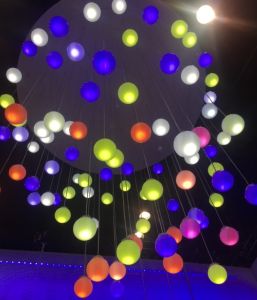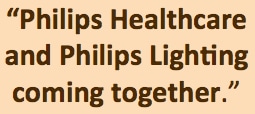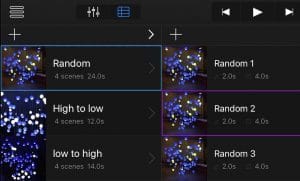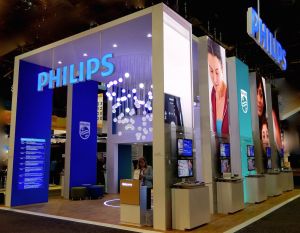An interview with an AVFX lighting designer regarding the chandelier used in the Philips HIMSS (Healthcare Information and Management Systems Society) trade show booth.
QUESTION: What’s the reason for having a chandelier in the booth?
DESIGNER: The chandelier symbolizes the cloud storage that all of the data is rising towards. The HIMSS show focuses on healthcare IT and now everything is happening in the cloud.
QUESTION: I know that you used the Philips Hue bulbs. Are those individually programmable?
DESIGNER: Yes. Each Hue bulb has a unique serial number. You pair the bulb with a bridge, at which point each individual bulb is then controlled by one of the two bridges that I used, in this case, sending signals out individually. You can’t group them like you can with a normal DMX unit. Each one has to be individually controlled.


DESIGNER: There were 86 bulbs hanging in the chandelier.
QUESTION: You had to program each one individually?
DESIGNER: Individually, yes, through all of the various cues. Each sequence had about four cues, so roughly 4 times 86 cues individually changed in terms of color and intensity. They needed to be pretty bright to pop through everything. The chandelier was also used for illumination of the presenters. There was a live presentation every hour.
QUESTION: Can you describe the visual effects?
DESIGNER: First, we created a random effect, alternating colors between green and blue and white.
Then 5-10 minutes before our presentation the entire chandelier would turn blue and then white would keep dropping from the top, like a white ring falling down.
To eliminate distraction, we changed to a static look during the presentation.
At the end of the presentation, the white ring would rise back up the cloud and the random effect would run until the next speaker.
QUESTION: How long did you have to actually program this?
DESIGNER: When you’re touching all 86 bulbs every single time it can take a while. The first couple days were trial and error, but once I figured out the kinks of working with the system, things progressed more quickly. Eventually I got down to about 15 minutes to create a sequence.

QUESTION: Were you programming in the Hue application?
DESIGNER: No. The only lighting board style item we needed was the Luminair iOS app. Luminair is a lighting control platform that gives lighting designers advanced wireless control over DMX-enabled lights and other equipment, as well as the next generation of “Smart” lights like Philips Hue. Luminair is built exclusively for iOS devices.
QUESTION: Will they use the chandelier design again?
DESIGNER: Yes. I know that there’s already been talk about putting the chandelier in every single booth for an extended period of time.

DESIGNER: Right. Which is why we made sure that there was signage on the booth saying, “Chandelier powered by Philips Hue.”
QUESTION: That’s great. Would you summarize by saying it was a success?
DESIGNER: Certainly the presentation of Hue was a success all around. Visitors were talking about it with the Philips staff. I made a joke about getting a commission. I’m sure we sold a lot of Hue lighting packages. People loved it. It wasn’t a ‘booth babe’ but the chandelier was definitely the draw. I would say, in that respect, it was a big success.
If you would like more information like this, subscribe to receive our email newsletter. [button type=”flat” shape=”square” size=”regular” href=”/subscribe/”]Subscribe[/button]